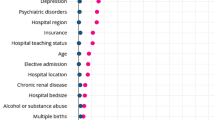Abstract
Objective
To evaluate the impact of obesity on the decision to delivery interval.
Study design
We compared the interval to delivery in normal, obese (BMI 30–40 kg/m2), and morbidly obese (BMI over 40 kg/m2) women. In a planned sub-analysis, we evaluated those who underwent emergency cesarean.
Results
We included 447 (25.3%) subjects: 157 normal, 200 obese, and 90 morbidly obese. We found no significant difference in the decision to delivery interval, mean ± SD (minutes): 39 ± 24, 44 ± 28, and 46 ± 28, p = 0.10. In the setting of emergency delivery we did find significantly prolonged intervals: 18 ± 8, 23 ± 16, and 30 ± 19 in non-obese, obese, and morbidly obese, respectively, p = 0.04.
Conclusion
We found similar decision to delivery intervals in women of varying BMI. In the setting of emergency cesarean delivery, we found increasing BMI to be associated with significant delays to delivery.
This is a preview of subscription content, access via your institution
Access options
Subscribe to this journal
Receive 12 print issues and online access
$259.00 per year
only $21.58 per issue
Buy this article
- Purchase on Springer Link
- Instant access to full article PDF
Prices may be subject to local taxes which are calculated during checkout

Similar content being viewed by others
References
Chauhan SP, Magann EF, Scott JR, Scardo JA, Hendrix NW, Martin JN Jr. Cesarean delivery for fetal distress: rate and risk factors. Obstet Gynecol Surv. 2003;58:337–50.
American College of Obstetrics and Gynecologists Committee on Professional Standards. Standards for obstetric-gynecologic services. 7th edn. Washington, DC: ACOG; 1989.
National Institute for Health and Care Excellence. Caesarean section guideline. London (UK): National Institute for Health and Care Excellence; 2011.
Tolcher MC, Johnson RL, El-Nashar SA, West CP. Decision to incision times and neonatal outcomes. Obstet Gynecol. 2014;123:536–48.
Girsen AI, Osmundson SS, Naqvi M, Garabedian MJ, Lyell DJ. Body mass index and operative times at cesarean delivery. Obstet Gynecol. 2014;124:684–9.
Conner SN, Tuuli MG, Longman RE, Odibo AO, Macones GA, Cahill AG. Impact of obesity on incision-to-delivery interval and neonatal outcomes at cesarean delivery. Am J Obstet Gynecol. 2013;209:e1–6. 386
Perlow JH, Morgan MA. Massive maternal obesity and perioperative cesarean morbidity. Am J Obstet Gynecol. 1994;170:560–5.
Doherty DA, Magann EF, Chauhan SP, O’Boyle AL, Busch JM, Morrison JC. Factors affecting caesarean operative time and the effect of operative time on pregnancy outcomes. Aust N Z J Obstet Gynaecol. 2008;48:286–91.
Marshall NE, Guild C, Chengy YW, Caughey AB, Halloran DR. Maternal superobesity and perinatal outcomes. Am J Obstet Gynecol. 2012;206:E1–6. 417
WHO. Obesity: preventing and managing the global epidemic. Report of a WHO Consultation. WHO Technical Report Series 894. Geneva: World Health Organization; 2000.
WHO. Physical status: the use and interpretation of anthropometry. Report of a WHO Expert Committee. WHO Technical Report Series 854. Geneva: World Health Organization; 1995.
Rossouw JN, Hall D, Harvey J. Time between skin indication and deliver during cesarean. Int J Gynaecol Obstet. 2013;121:82–85.
Yao R, Goetzinger KR, Crimmins SD, Kopelman JN, Contag SA. Association of maternal obesity with maternal and neonatal outcomes in uterine rupture. Obstet Gynecol. 2017;129:683–8.
American College of Obstetricians and Gynecologists. ACOG Practice Bulletin No. 106: intrapartum fetal heart rate monitoring: nomenclature, interpretation, and general management principles. Obstet Gynecol. 2009;114:192–202.
Lucas DN, Yentis SM, Kinsella SM, Holdcroft A, Mae AE, Wee M, et al. Urgency of cesarean section: a new classification. J R Soc Med. 2000;93:346–50.
Acknowledgements
Study data were collected and managed with REDCap software (Research Electronic Data Capture), which is hosted at Cincinnati Children’s Hospital Medical Center under the Center for Clinical and Translational Science and Training grant support (UL1-RR026314–01 NCRR/NIH). REDCap is a secure, web-based application that was designed to support data capture for research studies to provide (1) an intuitive interface for validated data entry, (2) audit trails for tracking data manipulation and export procedures, (3) automated export procedures for seamless data downloads to common statistical packages and (4) procedures for importing data from external sources. EDF’s contribution to this work was supported by the Perinatal Institute, Cincinnati Children’s Hospital Medical Center, Cincinnati, OH, USA.
Author information
Authors and Affiliations
Contributions
Both the authors contributed substantially to the production of this work.
Corresponding author
Ethics declarations
Conflict of interest
The authors declare that they have no conflict of interest.
Ethical approval
This work was approved by the local Institutional Review Board.
Additional information
Publisher’s note: Springer Nature remains neutral with regard to jurisdictional claims in published maps and institutional affiliations.
Rights and permissions
About this article
Cite this article
Turner, E., Warshak, C.R. Cesarean for non-reassuring fetal status: effect of obesity on decision to delivery interval. J Perinatol 39, 814–819 (2019). https://doi.org/10.1038/s41372-019-0351-8
Received:
Revised:
Accepted:
Published:
Issue Date:
DOI: https://doi.org/10.1038/s41372-019-0351-8



